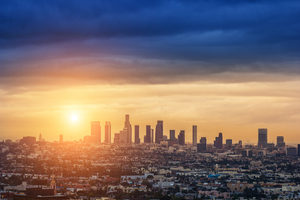If you experienced the same heat we did, you probably have one question: how did this happen?! We’re all conditioned to expect heat during LA summers, but this is ridiculous! Why did so many people lose power, and why didn’t they get it back for so long? Most importantly: how can I stay safe when this happens again? We were curious about each of these questions too, so we dug up some answers. Here’s what you should know about southern California’s brutal heat wave.
What Happened

Along with the heat came a huge energy strain, as hundreds of thousands of people all cranked up their AC at once. At peak activity, LA was using 6,256 megawatts of electricity. This high demand proved to be more than LA’s power grid could handle, and power outages swept the city. According to the Los Angeles Department of Water & Power, outages affected about 34,500 residents and businesses. Most outages lasted around 6 hours, but some residents were left without power for up to 24 hours.
Why the Heat Wave Happened
Unfortunately, this unusual weather pattern fits into a decades-long trend of more intense and frequent heat waves. Very hot weather happens because of bulging zones of high pressure called heat domes. The intensity of heat domes is evaluated by measuring “geopotential height.” The most intense heat domes reach geopotential heights of 6000 meters. The heat dome that caused Friday’s heat wave was one of these 6000+ domes. Frighteningly, domes like Friday’s are becoming more common. Almost all the 6000+ domes in the Western US occurred in 1990 or later. Meteorologists believe climate change is to blame for the new prevalence of very intense heat domes.
Why the Power Outage Happened
Overload-based power outages are tough to account for because they don’t happen all at once. Different parts of the electrical system overload at different times. On July 6, over 700 small, localized systems failed over the course of 24 hours. Each of these sections had to be restored one-by-one, which is a time-consuming process. Parts of LA also use primarily underground electrical utilities, which are harder to repair in case of overload damage. As of Monday, July 9, 1900 LA residents still don’t have power.
How To Stay Safe During Heat Waves
If you do lose your power, it’s vitally important you find other ways to keep cool. Always have water on hand and stay hydrated, even if you don’t feel thirsty. Avoid strenuous activity such as exercise, especially during the hottest part of the day. If you can, try to go somewhere with air conditioning. Limit your exposure to the sun if possible, and dress in loose-fitting, cool clothing. Check on anyone you know who would be particularly vulnerable to heat stroke, such as the elderly.
Of course, even if you do have power, it won’t matter if your air conditioning doesn’t work! Unfortunately, air conditioners can break or become ineffective surprisingly easy, and for all kinds of reasons. Often, we don’t even notice they’re not working right until we need them the most.
Making sure your AC works before a heat wave is a great way to keep yourself cool and safe. If you want some help with your AC, you can give Mike Diamond a call any time. We’ve got everything we need to repair and maintain your AC right. Stay cool this summer!